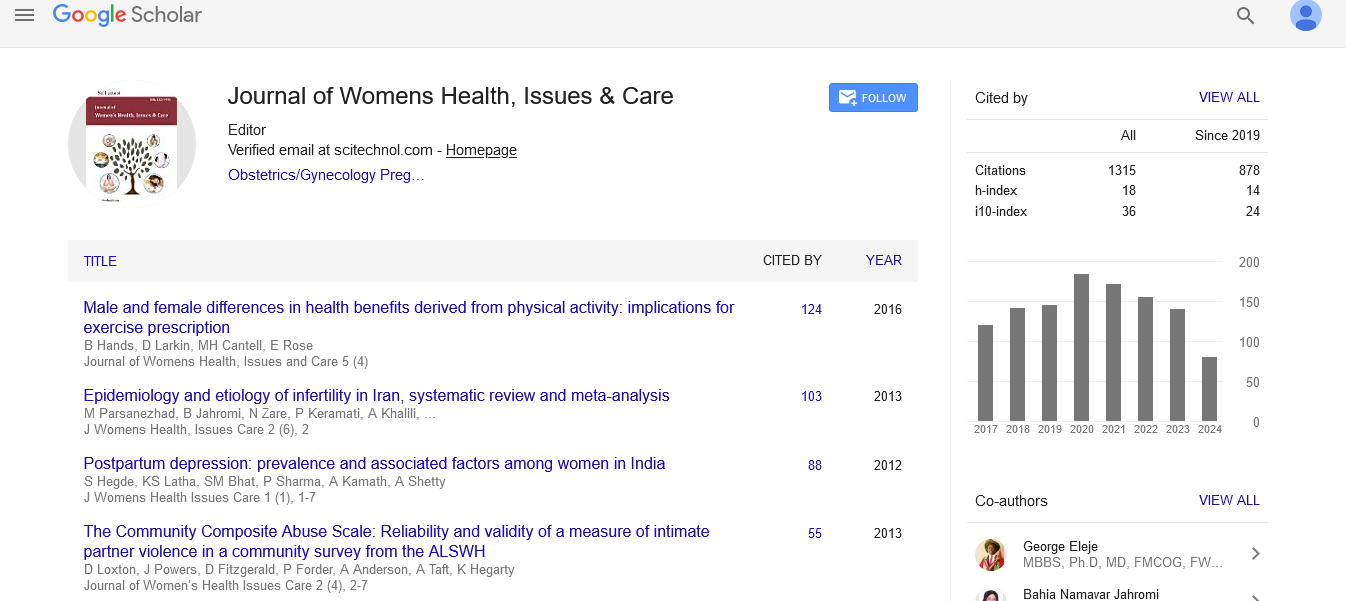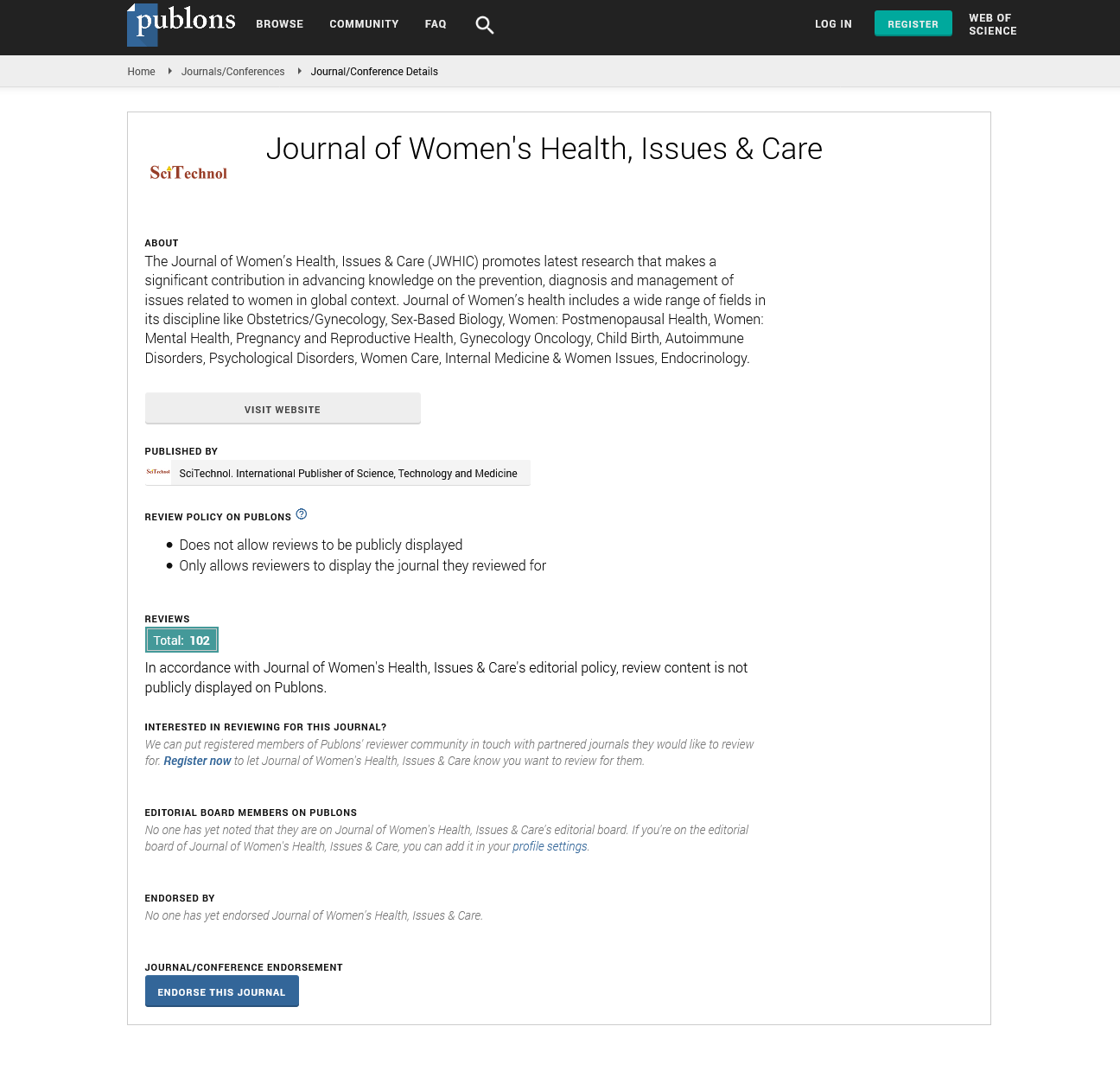Commentary, J Womens Health Vol: 13 Issue: 3
Women's Health and Infectious Diseases: An In-Depth Analysis of Risks and Prevention
Richard Powell*
1Department of Health Care, Monash University, Melbourne, Australia
*Corresponding Author: Richard Powell,
Department of Health Care, Monash
University, Melbourne, Australia
E-mail: powellrichards@gmail.com
Received date: 31 May, 2024, Manuscript No. JWHIC-24-140048;
Editor assigned date: 03 June, 2024, PreQC No. JWHIC-24-140048 (PQ);
Reviewed date: 18 June, 2024, QC No. JWHIC-24-140048;
Revised date: 26 June, 2024, Manuscript No. JWHIC-24-140048 (R);
Published date: 04 July, 2024 DOI: 10.4172/2325-9795.1000499.
Citation: Powell R (2024) Women's Health and Infectious Diseases: An In-Depth Analysis of Risks and Prevention. J Womens Health 13:3.
Description
Infectious diseases pose significant health risks worldwide, with women facing unique vulnerabilities due to biological, socio-cultural, and behavioral factors. Addressing the complexities of infectious diseases in women requires understanding how these factors interact and influence disease transmission, diagnosis, treatment, and outcomes.
Biological vulnerabilities
Biological vulnerabilities involved in infectious diseases:
Reproductive anatomy: Women's reproductive anatomy makes them more susceptible to certain infections. The structure of the female reproductive tract facilitates the entry and spread of pathogens, increasing the risk of Sexually Transmitted Infections (STIs) such as chlamydia, gonorrhea, and Human Papillomavirus (HPV).
Hormonal influences: Hormonal fluctuations across a woman’s lifespan can impact susceptibility to infections. For example, estrogen influences the vaginal microbiome, which provides a protective barrier against pathogens. During menopause, decreased estrogen levels can lead to a less protective vaginal environment, increasing the risk of infections. Pregnancy alters the immune response, making pregnant women more susceptible to infections like Urinary Tract Infections (UTIs) and listeriosis, which can have severe implications for both mother and fetus.
Immune system differences: Women’s immune responses differ from men’s, influenced by genetic and hormonal factors. Women generally mount stronger immune responses, which can be protective against some infections but also increase the risk of autoimmune diseases. These immune differences affect how women respond to infections and vaccines, necessitating customized approaches in prevention and treatment.
Infectious diseases of particular concern
Major infectious diseases are:
Sexually Transmitted Infections (STIs): STIs remain a significant health concern for women. Infections like chlamydia and gonorrhea can lead to Pelvic Inflammatory Disease (PID), infertility, and ectopic pregnancy if left untreated. HPV, a common STI, is the primary cause of cervical cancer. Regular screening and vaccination are important for prevention and early detection of STIs and related complications.
Human Immunodeficiency Virus (HIV): Women account for nearly half of all HIV infections globally, with transmission primarily occurring through heterosexual contact. Pregnant women with HIV risk transmitting the virus to their infants during childbirth or breastfeeding. Prevention strategies include education, and Antiretroviral Therapy (ART) to reduce viral load and prevent motherto- child transmission.
Urinary Tract Infections (UTIs): UTIs are more common in women due to the shorter urethra, which facilitates bacterial entry. Pregnancy and menopause further increase the risk. UTIs can lead to complications such as kidney infections if not properly managed. Prevention strategies include proper hygiene, adequate hydration, and timely treatment.
Human Papillomavirus (HPV): HPV infection is a leading cause of cervical cancer in women. While many HPV infections are asymptomatic and resolve spontaneously, persistent infections with high-risk strains can lead to cervical dysplasia and cancer. HPV vaccination and regular cervical screening (Pap smears) are key preventive measures.
Strategies for prevention and control
Prevention and control measures include:
Vaccination: Vaccines play an important role in preventing infections such as HPV and hepatitis B, which disproportionately affect women. Expanding access to vaccination programs, particularly in low-resource settings, is essential for reducing the burden of these diseases.
Education and awareness: Educating women about infectious diseases, risk factors, and prevention strategies is vital. Public health campaigns can promote awareness about safe sexual practices, the importance of vaccination, and the benefits of early diagnosis and treatment.
Improved access to healthcare: Enhancing access to healthcare for women through affordable services, community outreach, and telemedicine can facilitate timely diagnosis and treatment. Integrating infectious disease prevention and management into existing maternal and reproductive health services can improve outcomes.
Research and policy advocacy: Continued research into genderspecific aspects of infectious diseases and their impact on women is very important. Advocacy for policies that address gender disparities in healthcare, including funding for women-specific health programs and services, can support better health outcomes.
Conclusion
Infectious diseases in women are influenced by a combination of biological, socio-cultural, and economic factors. Addressing these challenges requires comprehensive strategies that include education, improved access to healthcare, vaccination, and policy advocacy. By recognizing and addressing the unique vulnerabilities women face, we can enhance prevention, early detection, and treatment of infectious diseases, ultimately improving health outcomes for women worldwide.
 Spanish
Spanish  Chinese
Chinese  Russian
Russian  German
German  French
French  Japanese
Japanese  Portuguese
Portuguese  Hindi
Hindi 



